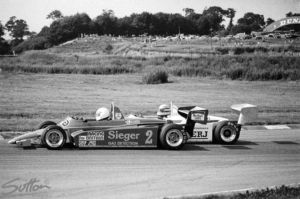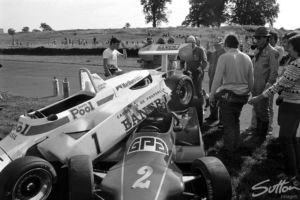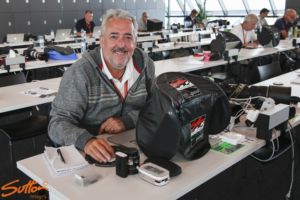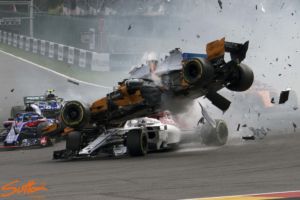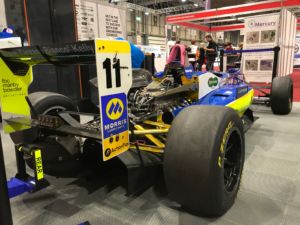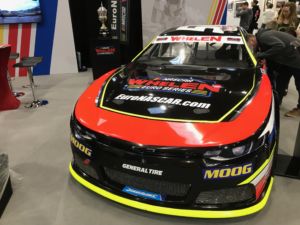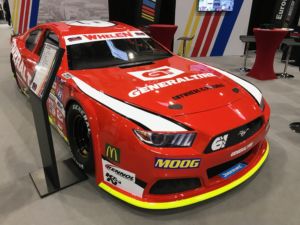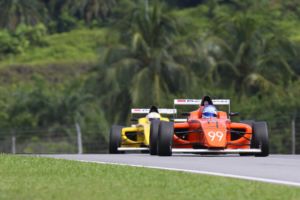For the second year in a row, the World Rally Championship came to The NEC Birmingham. The only difference was that instead of just the Thursday media day, it was held on the first public day, Saturday the 12th of January.
There was massive interest around the display of full-blooded cars from M-Sport, Toyota WRC Team, Hyundai Motorsport and Citroen Racing ahead of the launch, with the cars all covered up. Then the teams arrived and the cars were unveiled. First the Fiesta WRC, followed by the Yaris WRC, i20 WRC and finally the C3 WRC.
Afterwards, I got to speak to the new co-drivers for Kris Meeke, Teemu Suninen and Elfyn Evans. They are, Seb Marshall, Marko Salminen and Scott Martin.
First up, Scott. I asked him how he came to join Elfyn in the car?
He said, well Dan and Elfyn weren’t going to continue in 2019, so the opportunity came about. Unfortunately, Craig didn’t have anything organised, no programme to offer, so yeah it wasn’t easy a difficult situation to be in, ultimately an opportunity to have a full season in the WRC and Craig didn’t have something solid, so that’s how it came all about. Since then we’ve been working hard to work together and look forward to the year, to try and put as much preparation in as we can going into Monte-Carlo.
In terms of preparing for the season and in particular Monte-Carlo, you’ve been testing?
Well, that was great to get in the car that we’ll be rallying, and I’ve never competed with Elfyn before, never sat in the car with him before. We’d done some pace note work, around my home in the UK, you know just to understand the notes a bit, we watched on board videos, I watched a lot of Dan and Elfyn from last year, just to try and understand a little bit, but until you actually sit in the car with him and actually go through the motions and get the feelings of how he drives to the notes, that’s when you really get to learn, you get areas I need to get more familiar with and then you go from there. Now there are loads of things we can be doing now and now we’ve actually done the test a lot of things work well and there’s some areas we need to work on to understand each other, so it’s a work in progress and we’ll keep working hard at it and try and be in the best possible way when we start Monte Carlo Rally.
What are your hopes for Monte?
I hope we have a clean rally, I hope we work well together and hope we have a good result.
In terms of preparation for Monte, how many kilometres have you done?
We were sharing the car both days with Teemu, but we probably got about 300km over the two days as a crew, and as a team maybe six to seven hundred. We had all the conditions you’d probably expect to get at Rallye Monte-Carlo, so this was really good. I feel like we had a good test on that point. It was always changing, we were able to do a lot of tyre work and just make sure the car felt comfortable in these tricky conditions, so I think that’s key to have a good result in Monte-Carlo. Yeah, we had a good two days. Now we’ve got to work with the gravel crew, that’s the unique thing about Monte-Carlo, that’s a relationship that Elfyn already has, need to build that up, so that when it comes to Thursday night, we know what we’re all doing.
Is Phil Mills still in the gravel car with Elfyn’s dad?
Actually, there’s been a bit of a change there. Phil Mills is a bit tied up with work, so Elfyn’s got a friend of his that’s co-drove for him before, (it’s not Dan Barritt, Scott said whilst laughing), so I’m working with him and we’re all working together and will continue that right up to the rally. Looking forward to it!
Next up was Seb Marshall.
I asked him testing and preparations have gone for Rallye Monte-Carlo?
Yes, it’s gone well. We’ve had two days before Christmas, and it was the first time that myself and Kris had been in the car together at speed and the first time with the team as well. The first day was on a road that we know quite well, absolutely bone-dry conditions perfect for feeling your way into the car in a very consistent environment. The second day, we were on a new road that in the morning had five kilometres of sheet black ice, that melted throughout the day to get the slush and mud, so it was difficult but, in some ways, it was perfect Monte testing. The feeling as good, it’s one of those events so much is down to tyre choice, that’s it’s not all down to set up, but feeling comfortable in the car.
Do you know how many kilometres you covered over the couple of days?
Something like 350km’s I would have thought. About par for a testing day.
How did the switch from Hayden come about?
Well, towards the last year Kris was in talks with Toyota, managed to sign his deal and felt he wanted to have a change of things in the car. So, he approached me, and asked what I was up to this year, if it something I’d be interested in, so kept talking across the weeks and went from there. So, its wasn’t that I was looking to leave or jump ship, it was just case that an opportunity presented itself. For me, despite I’d been around the championship for a while, I’d never done a full season. Now it’s great to compete at this level, doing anything but of course the chance to do the full championship is quite a big thing, so that was quite a big draw, you know a driver of his calibre, it’s a good opportunity!
Marko Salminen was next.
I asked how good it was that it would be that he would be doing a full season in his debut year?
Ah, well that has been my dream for many years, and now it’s coming true and I’m really looking forward to it and working with Teemu, it’s so good too. He’s a good guy and easy to work with, and I’m just enjoying it and waiting for the season to start.
Now, you were testing this week and sharing the car with Elfyn and Scott?
Yeah, we did two day’s with Teemu and luckily there were some snowy conditions and ice, that kind of stuff, so it really helped to prepare and understand ahead of the rally.
Okay, give us your first impressions of the car.
Of course, the first time, it was amazing but after a few runs you get used to the speed, but I can say that they really go fast!
Now, speaking to Teemu I asked him how his relationship with Marko, his new co-driver was?
Yes, it’s been good at the moment. I know him from 2014 when I was driving against him in the Finnish Championship, and the last two years he’s been driving with Takamoto, who has been driving in WRC2, he has good experience from WRC cars. After the season, I just had a phone call to him, would you be interested to come and co-drive me, as I felt that he had something to give me in the car.
Now, you’ve also got a new suspension partner, in the team. How has that integration gone so far?
The challenge is to change one part of the car because to see how it works with the other parts, so it’s not so easy to find a good balance in the car immediately, but I see it holds good possibilities to improve the car, but we just need the time.
Elfyn next up!
How are things going with Scott?
So far, it’s been really good, we have a lot of preparation now to do before we head to Monte Carlo, it’s probably one of the most complex events to start a new partnership just because there’s the integration of the gravel notes, the way you process the weather information, means everything is much more complex. There’s a lot to get through before Monte Carlo and we’ve only had two half days testing, so it’s a relatively short time to prepare. We’re doing a lot of recce outside of rally, just on normal roads to try and get used to one-another and so far, so good. I’m confident it will turn out okay.
I asked him about the return of Kris to the championship.
Yes, it’s great, I think Kris’ speed is unquestioned, and for the UK it’s a massive thing to have another Brit back full time. Really pleased for Kris and Seb to be there.
Hyundai Motorsport
I asked Andreas Mikkelsen about if he felt any pressure heading into his second full season, after just one podium in 2018.
Ah, no not chilled. We know we need to deliver, we cannot have another year like 2018, it was a difficult year, the luck was definitely not on our side on many occasions as well but we feel like we’ve taken some steps and we feel confident that we will be back to where we belong, where we normally are. But we know what an important season this is.
I asked Thierry Neuville about his lack of pace in Rally Finland and what he could do to improve it?
We have tried everything in the last five years and in particular the last three years to improve. We come back from testing with the feeling we are fast and then obviously we are not. It’s difficult to say now because now Toyota has clearly a big advantage with their test area in the Finnish woods and knowing that the testing, they benefit from it. The speed is extremely high, but even compared to Citroen which doesn’t test so much over there, they were faster than us there, which was a bit of a surprise.
Part two of my interviews will be up soon, so do pop back and check in.



